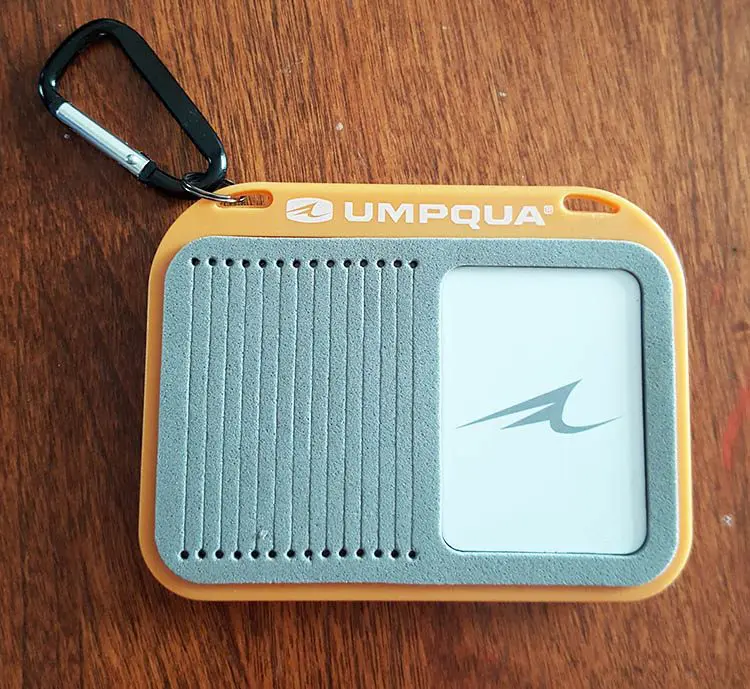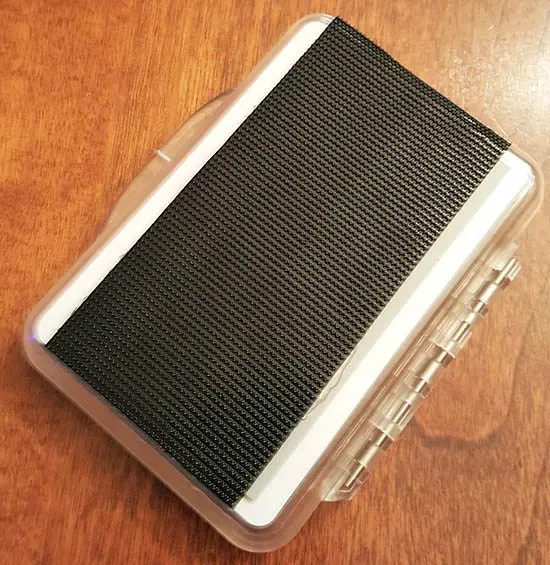Remember that old faithful fly patch that came with your first fishing vest? The 3 inch square of sheeps wool that was so thick it seemed to eat flies? Well it’s long gone and has been replaced with micro-slit foam and high powered magnets that can hold a days worth or more of flies. We purchased and tested three of the best patches on the market, and even made one of our own to find out who makes the best fly patch.

Contenders for the Best Fly Patch

Rating: 4.5 / 5
Pros:
- Holds a ton of flies.
- Flip down shelf.
- Great design.
Cons:
- High price tag.

Rating: 2 / 5
Pros:
-
- Holds and protects.
- Strong magnets.
Cons:
-
- Hard to access flies.
- Doesn’t hold much.
- Poor design.

Rating: 4 / 5
Pros:
-
- Magnetic patch.
- Good capacity.
- Multiple attachment points.
- Low Profile.
Cons:
-
- Micro-Slits tear.

$10 DIY Fly Patch
Retail Price: $10
Rating: 3 / 5
Pros:
-
- Price.
- Capacity.
Cons:
-
- Looks DIY.
The Tacky Tube

When I first saw the Tacky Tube I was intrigued. It’s round design, big magnets and the classic Tacky silicone panels looked pretty cool. I opened it, closed it, looked at it from all angles trying to figure out if they had come up with something brilliant, or just another 20 dollar vest accessory that would eventually end up at the bottom of the gear bag.
Fourteen rows of Tacky’s patented silicon micro slits will definitely hold your flies in place, as will the high powered center magnets. I loaded it up with midges, dries, nymphs and terrestrials, closed the tube and shook the heck out of it trying to dislodge something. It held fast. Impressive. It definitely passes the ‘holds flies well’ test with flying colors and if you’ve ever owned a Tacky Fly Box, you won’t doubt that. Couple that with this tube design and nothing will snag or knock your flies off if you have to go bushwhacking.

Where the Tacky Tube falls short is in the ease of storing and retrieving flies. In fact the tubular design, which protects flies so well, is the biggest drawback. I have relatively normal sized fingers but with the curved design, it’s very difficult to get your fingers in it to place your flies. The space gets very cramped and I found it almost impossible to place flies anywhere but on the outer edge of the tube.
The curved tube also bunches up your flies because they are all angled in on each other. It makes them tough to place in the slits and tough to get out. I was only able to store 28 flies in the silicone, one per row, because of this issue. Compare that to other fly patches that hold 75 or more and it’s tough to see this being useful for a long day of fishing. Plus, I struggled enough loading it at my kitchen table that I would definitely lose my patience with it on the water.

The high powered, center magnets worked great holding my midges and small emergers. Even after the shake test the flies hadn’t budged and they were easy to get to.

As for being the best fly patch, the Tacky Tube doesn’t cut it, it was just too difficult to use. I would definitely take another look if it came in a slightly larger size and in more of rectangular shape.
Umpqua Fly Badge

The Umpqua Fly Badge has a patch of micro-slit foam and a strong magnetic patch for smaller flies. It’s low profile and attaches well to any vest or pack.
One of the best features is the large, magnetic surface that is surprisingly strong. It also passed the ‘shake the heck out of it’ test with flying colors. But, unlike the other patches with magnetics, this has a larger surface so you can move your flies around with your fingers which makes picking up small flies much easier. I really like this.

The fly badge attaches to your vest or sling pack with either the included carabiner, or the belt and suspenders option of two pins AND/OR a big patch of super strong velcro. One thing is for sure, this thing isn’t going anywhere!

I found that the micro-slit foam of the Umpqua Fly Badge did tend to tear when you remove flies from it, so I’m not sure how long it will hold up. Otherwise it’s an awesome, low profile, high capacity fly patch that is a serious contender for the best fly patch.
C&F Designs Chest Patch

If you are looking for the Cadillac of fly patches the C&F Chest Patch has more features than a Cineplex and a big price tag to go with it. Capable of holding over 75 flies between the micro-slit foam, fly threader, and 6 high powered magnets in the lid. That doesn’t even include the dense foam on the front of the patch that holds even more. It’s hands down the winner of capacity in the battle of the best fly patch.
One of my favorite features is the 90 degree hinge shown in image above and below. When fully open it creates a shelf which is handy for sorting through flies and it latches back up when you are done. I found this to be unique and really helpful.

The front of the patch is also covered with a dense foam for even more fly storage, much like a traditional fly patch. This takes the potential fly capacity to about 100. For most of us, that’s more than you would ever need. So I guess we can get rid of all those cool fly boxes that we know and love (I don’t think so).

The C&F Chest Patch attaches with either the heavy duty pin on the back or with two plastic carabiners that connect to the small plastic rings in the corner. I’m not a fan of anything that hangs off my pack, especially a fly patch. I feel like it’s just inviting your flies to snag on something.

While it may look like a C&F fly box, the ends are actually open so your wet flies can dry out and hopefully not rust. This also protects your flies from being knocked off or snagged.

As with most of the C&F products, the great design and function comes with a price. The version of the Chest Patch we reviewed, with 5 rows of micro-slits and threader retails for $38.50 which is what you would spend on a premium fly box. So it’s definitely suited towards the fisherman who has a need to carry a ton of flies, the minimalist who wants to carry a days worth on their chest or the angler who just likes the best gear regardless of price.
$10 DIY Fly Patch

If you’re a do it yourself-er and want to create your own best fly patch, you can for around 10 bucks! It will hold dozens of flies and has all the bells and whistles. After looking at everything on the market I wanted to see if I could come up with something better. I picked up a small, Superfly Micro Slit fly box at my local Field and Stream for $8, velcro, magnets and super glue from Lowe’s and headed home to experiment.

The DIY patch will hold a ton of flies and has a clear cover which will become a work surface and magnetic fly holder. On the back I used some industrial strength velcro (similar to what’s on the back of the Umpqua Fly Badger) to make sure this thing stays put. Inside the cover I glued four super power magnets for small flies like midges and emergers. They also catch flies that may fall out of the main compartment.

I attach the fly patch to my sling pack so the lid flips down making it a useful tray of sorts. The cover keeps the flies protected from snags and getting your flies in and out is a snap.
Industrial strength velcro covers the back. I added a little super glue to make sure it never peels off. It holds well to any vest or pack.

If you are interested in your own $10 DIY Fly Patch search Amazon for ‘small fly box‘… they have a ton. Local craft stores are stocked with more velcro and magnets than you need as well.
So Who Makes the Best Fly Patch?
We gave the C&F Designs Chest Patch 4.5 out of 5 stars so technically it won Best Fly Patch. It holds a ton of flies, has a low profile, quality micro-slit foam AND a threader. The design is flat out cool as is most of the C&F Design products. We came to terms with the high price as it can hold as much, or more, than the average fly box.
The runner up is the Umpqua Fly Badge. I really like the large magnetic surface, the low profile and the belt and suspenders attachment points. But, I don’t think the micro-slit foam will hold up well over time. This is where the C&F Chest Patch wins.
As for the Tacky Tube, it’s an interesting design but in my opinion a poor one. It’s just too difficult to get flies in and out and it really doesn’t hold much.
The $10 DIY option was a lot of fun to put together but I can see it ending up more as a fly box than a patch. I think it proves the point that if you really want to, you can create and customize gear to your liking without breaking the bank.
I hope this article helps if you are in search of a new fly patch. There are a lot of options out there but I feel we have highlighted some good ones and found the best fly patch.
As always, thank you for taking the time to visit Gear Cloud. We appreciate your time and your support.

